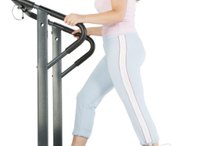Can I Use an Elliptical If I Have Shin Splints?
The shin contains muscles that run down the front of the tibia, called the tibialis anterior. Shin splints is known clinically as medial tibial stress syndrome, or MTSS.
This causes pain and inflammation in the muscles, tendons and outer layer of tissue on the tibia, according to the American Academy of Orthopaedic Surgeons. An elliptical is a machine that simulates cross-country skiing. When you are trying to recover from shin splints, this machine might be just what you need.
Identification
Excessive running is one of the main causes of shin splints.
Running on rough terrain, running downhill and making fast starting and stopping motions while running are particularly likely to cause the problem. Once you place your feet on the pedals of an elliptical, they stay there for the entirety of your workout. This causes no impact on your shins, meaning the machine is safe to use if you have shin splints.
- Excessive running is one of the main causes of shin splints.
- This causes no impact on your shins, meaning the machine is safe to use if you have shin splints.
Joint Movement
Running and Pain in the Tibialis Anterior Muscle
Learn More
When you exercise on an elliptical, you work your upper and lower body, and incorporate multiple joints. To activate your tibialis anterior, you need to point your toes upward. This motion, called dorsiflexion, is prominent when you run, but not when you use an elliptical machine. While you glide back and forth, your feet remain stable, and there is only a slight change in joint angle.
This causes you to contract your anterior tibialis muscles isometrically to keep your lower legs stable, but there is no major stress on your shins. An isometric movement is one in which you hold a contraction without repetitive movement.
- When you exercise on an elliptical, you work your upper and lower body, and incorporate multiple joints.
Warm-Up
Before you step onto an elliptical, you should always do a few stretches, especially if you have shin splints. This can loosen up your lower leg muscles and prevent the symptoms from getting worse while you exercise.
Ankle bounces are examples of dynamic stretches that lengthen the calf muscles, which are on the back of the lower legs. Dynamic stretches are performed in motion. To do ankle bounces, place your hands on a wall, lean forward and quickly lift and lower your heels.
- Before you step onto an elliptical, you should always do a few stretches, especially if you have shin splints.
- Ankle bounces are examples of dynamic stretches that lengthen the calf muscles, which are on the back of the lower legs.
Considerations
Do You Burn More Fat Holding Onto the Rails on a Treadmill or Not?
Learn More
Toe taps and heel walks are corrective exercises for shin splints. By doing these, you will strengthen your tibialis anterior muscles and further treat your symptoms. To do toe taps, stand or sit with your heels on the floor and toes in the air. Carefully tap the floor with your toes and lift them back into the air. An upward facing dog is a yoga pose that can help stretch your anterior tibialis muscles. This is performed from a face-down position on your stomach. Place your hands about shoulder-width apart and place the top of your feet flat on the floor.
Push yourself up until your arms are fully extended and lift your thighs off the floor. Once your hands and feet are the only points of contact with the floor, hold for 30 to 45 seconds and release.
- Toe taps and heel walks are corrective exercises for shin splints.
- Push yourself up until your arms are fully extended and lift your thighs off the floor.
Prevention/Solution
To avoid getting shin splints in the first place, there are several preventive measures to take. One of the most important is to make sure you wear comfortable shoes that are not worn out.
You can also wear arch supports to take pressure off your shins. When you work out, do not exercise for excessive amounts of time. This includes elliptical training or any other type of training. Overtraining can cause excess strain on your shins.
- To avoid getting shin splints in the first place, there are several preventive measures to take.
- You can also wear arch supports to take pressure off your shins.
Related Articles
References
- AAOS: Shin Splints
- The Complete Book of Running for Women; Claire Kowalchik
- Brian Mac: Dynamic Stretching Exercises
- Yoga Journal: Upward-Facing Dog
- Winkelmann ZK, Anderson D, Games KE, Eberman LE. Risk factors for medial tibial stress syndrome in active individuals: An evidence-based review. J Athl Train. 2016;51(12):1049-1052. doi:10.4085/1062-6050-51.12.13
- Pietrzak M. Diagnosis and management of acute medial tibial stress syndrome in a 15 year old female surf life-saving competitor. Int J Sports Phys Ther. 2014;9(4):525–539.
- Galbraith RM, Lavallee ME. Medial tibial stress syndrome: Conservative treatment options. Curr Rev Musculoskelet Med. 2009;2(3):127-133. doi:10.1007/s12178-009-9055-6
- Reinking MF. Exercise related leg pain (ERLP): A review of the literature. N Am J Sports Phys Ther. 2007;2(3):170-180.
- Nielsen RO, Buist I, Sørensen H, Lind M, Rasmussen S. Training errors and running related injuries: A systematic review. Int J Sports Phys Ther. 2012;7(1):58–75.
- Alaia MJ, Fischer SJ. Shin Splints. OrthoInfo. American Academy of Orthopaedic Surgeons. Reviewed August 2019.
- Ma CB, Zieve D, Conaway B. Shin Splints - Self Care. MedlinePlus NIH. Reviewed November 5, 2018.
- Moen MH, Tol JL, Weir A, Steunebrink M, De Winter TC. Medial tibial stress syndrome: A critical review. Sports Med. 2009;39(7):523-46. doi:10.2165/00007256-200939070-00002
- Reshef N, Guelich DR. Medial tibial stress syndrome. Clin Sports Med. 2012;31(2):273-90. doi:10.1016/j.csm.2011.09.008
Writer Bio
I am very genuine and magnetic on camera, and have made numerous videos on my own for clients and other organizations that I'm affiliated with. I also have a degree in Sport Management, and multiple certifications to back up my validity. I've also been featured in three different exercise infomercials and had a speaking role in a National Lampoons movie.









